(a) Location, orientation, size and shape of buildings.
(1) The linear continuity of buildings shall be preserved by placing primary facades parallel to the street.
(2) New and remodeled buildings shall be compatible with their surroundings. Architectural style, bulk, shape, massing, height, scale and form of new and remodeled buildings and the shape between and around buildings shall be consistent with the character of the area and be in harmony with neighboring buildings. Building design and materials shall also be compatible with the historic residential and institutional structures in the city and include gable roofs and residential-type windows and doors.
(3) Buildings with a facade in excess of 50 feet shall be divided into modules not exceeding 50 feet in width. Each module may have a separate entry, display windows and/or other architectural features to distinguish it from adjacent modules.
(b) Exterior renovation or alteration of existing historic structures.
(1) The distinguishing original qualities of an historic building or structure shall not be destroyed. The removal or alteration of any historic materials or distinctive architectural features shall not occur whenever possible.
(2) Existing houses which are converted to commercial uses shall retain the residential character and general construction design of the period of the structure.
(3) Architectural elements shall be sensitively designed to reflect detailing associated with the particular style of the building.
(4) The design elements of a building addition shall match the design elements of the principal structure, in particular, building materials and color, roof lines and shapes, and window proportions and alignment.
(5) The scale of an addition shall be compatible with the principal structure and surrounding structures and context.
(6) The original pattern of window and door openings and their shape and configuration shall not be altered unless approved by the Planning and Zoning Commission. Window and door openings should not be reduced, enlarged or filled-in on street facade. Replacement windows and doors should match the original size, shape and design as closely as possible.
(7) Original materials shall be repaired, restored and reused whenever possible. Original materials shall not be removed or covered whenever possible. Where necessary missing or deteriorated materials shall be replaced with appropriate recycled or new materials which match the original as closely as possible.
(c) Building materials and appurtenances.
(1) The architectural character and exterior building materials of new and remodeled buildings shall be harmonious with nearby historic buildings in color and texture, materials, proportion, scale, patterns and opening sizes and shapes.
(2) Construction materials and colors for walls and fences that are visible from the street shall be uniform and compatible with the architectural style, color and building material of the building and its surroundings.
(3) Accessory buildings shall be compatible in design and material with the main structure.
(d) Building and lot aesthetics. The specific guidelines for building and lot aesthetics in this subsection have been formatted to provide an illustration of the acceptable and not acceptable methods of building design as it relates to height, scale, massing, setback and other issues. For each specific guideline that follows a description of the recommended approach that the applicant/property owner should "consider" is provided, with an illustration of the result of the design. Similarly, a description is provided of the design approach that the applicant/property owner should "avoid" when designing or remodeling structures in this District.
(1) Height:
A. Acceptable. Relating the overall height of new construction or renovation of existing structures to that of adjacent structures.

B. Not acceptable. New construction that greatly varies in height (too high or too low) from older buildings in the vicinity.
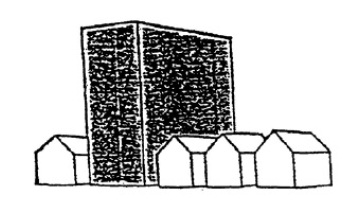
(2) Scale:
A. Acceptable. Relating the size and proportions of new structures to the scale of adjacent buildings. Although much larger than its neighbors in terms of square footage, the building shown maintains the same scale and rhythm as the existing buildings.
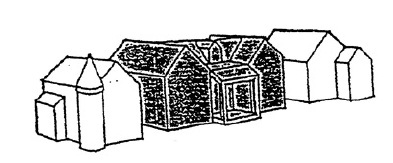
B. Not acceptable. Buildings that in height, width or massing violate the existing scale of the area. The new building shown here disrupts the scale and rhythm of the streetscape.
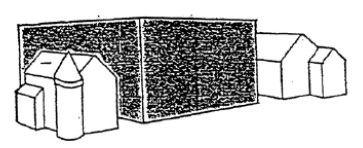
(3) Massing:
A. Acceptable. Breaking up uninteresting boxlike forms into small, varied masses such as are common on most older buildings. Variety of form and massing are elements essential to the character of the streetscape.
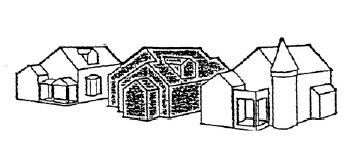
B. Not acceptable. Single, monolithic forms that are not relieved by variations in massing. Boxlike facades and forms are intrusive when placed in a streetscape of older buildings that have varied massing and facade articulation.

(4) Directional expression:
A. Acceptable.- Relating the vertical, or nondirectional facade character of new buildings to the predominant directional expression of nearby buildings. Horizontal buildings can be made to relate to the more vertical adjacent structures by breaking the facade into smaller masses that conform to the primary expression of the streetscape.

B. Not acceptable. Strongly horizontal or vertical facade expressions unless compatible with the character of structures in the immediate area. The new building shown does not relate well to either its neighbors or to the rhythm of the streetscape because of its unbroken horizontal facade.

(5) Setback:
A. Acceptable. Maintaining the architectural facade lines of streetscape by locating front walls of new building in the same plane as the facades of adjacent buildings. If existing setbacks vary, new building should conform to historic sitting patterns.
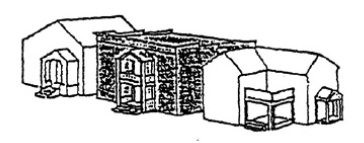
B. Not acceptable. Violating the existing setback pattern by placing new buildings in front of or behind the historic facade line. Avoid placing buildings at odd angles to the street, unless in an area where diverse sitting already exists.
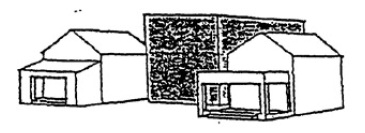
(6) Sense of entry:
A. Acceptable. Articulating the main entrances to the building with covered porches, porticos and other pronounced architectural forms.
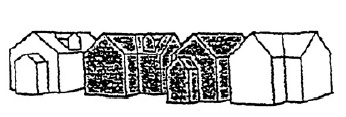
B. Not acceptable. Facades with no strong sense of entry. Side entries or entries not defined by a porch or similar transitional element result in an incompatible "flat" first floor facade.

(7) Roof shapes:
A. Acceptable. Relating the roof forms of the new building to those found in the area. Although not entirely necessary, duplication of the existing or traditional roof shapes, pitches and materials on new construction is one way of making new structures more visually compatible.
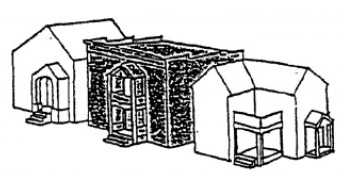
B. Not acceptable. Introducing roof shapes, pitches or materials not traditionally used in the area.

(8) Rhythm of openings:
A. Acceptable. Respecting the recurrent alternation of wall area with door and window elements in the facade. Also consider the width-to-height ratio of bays in the facade. The placement of openings with respect to the facade's overall composition symmetry, or balanced asymmetry, should be carefully studied.

B. Not acceptable. Introducing incompatible facade patterns that upset the rhythm of openings established in surrounding structures. Glass walls and window and door shapes and their locations shown in the example are disrespectful to the adjoining buildings.
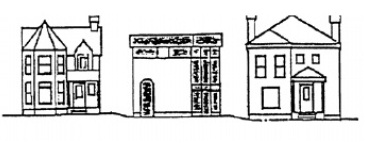
(Ord. 10-O-35, passed 7-21-2010)